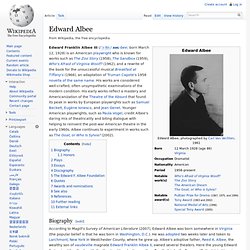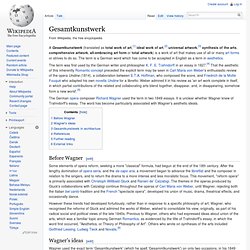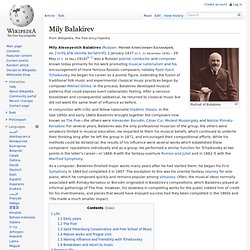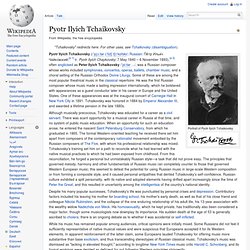

Jean Genet. Edward Albee. Biography[edit] According to Magill's Survey of American Literature (2007), Edward Albee was born somewhere in Virginia (the popular belief is that he was born in Washington, D.C.).

He was adopted two weeks later and taken to Larchmont, New York in Westchester County, where he grew up. Albee's adoptive father, Reed A. Albee, the wealthy son of vaudeville magnate Edward Franklin Albee II, owned several theaters. Here the young Edward first gained familiarity with the theatre. Albee left home for good when he was in his late teens. Albee moved into New York's Greenwich Village, where he supported himself with odd jobs while learning to write plays. Eugène Ionesco. Gesamtkunstwerk. A Gesamtkunstwerk (translated as total work of art,[1] ideal work of art,[2] universal artwork,[3] synthesis of the arts, comprehensive artwork, all-embracing art form or total artwork) is a work of art that makes use of all or many art forms or strives to do so.

The term is a German word which has come to be accepted in English as a term in aesthetics. The German opera composer Richard Wagner used the term in two 1849 essays. It is unclear whether Wagner knew of Trahndorff's essay. The word has become particularly associated with Wagner's aesthetic ideals. Richard Wagner. Giuseppe Verdi. Biography[edit] Early life[edit] Verdi's statue in the Piazza G. Verdi, Busseto When he was still a child, Verdi's parents moved from Le Roncole to Busseto, where the future composer's education was greatly facilitated by visits to the large library belonging to the local Jesuit school. Aida. Aida (Italian: [aˈiːda]), sometimes spelled Aïda, is an opera in four acts by Giuseppe Verdi to an Italian libretto by Antonio Ghislanzoni, based on a scenario often attributed to French Egyptologist Auguste Mariette, although Verdi biographer Mary Jane Phillips-Matz has argued that the scenario was actually written by Temistocle Solera.[1] Aida was first performed at the Khedivial Opera House in Cairo on 24 December 1871, conducted by Giovanni Bottesini.
Aida: The Grand March. Gilbert and Sullivan. Gilbert and Sullivan refers to the Victorian-era theatrical partnership of the librettist W.

S. Gilbert (1836–1911) and the composer Arthur Sullivan (1842–1900) and to the works they jointly created. The two men collaborated on fourteen comic operas between 1871 and 1896, of which H.M.S. Pinafore, The Pirates of Penzance and The Mikado are among the best known.[1] I Am the Very Model of a Modern Major-General. Mily Balakirev. Portrait of Balakirev Mily Alexeyevich Balakirev (Russian: Милий Алексеевич Балакирев, IPA: [ˈmʲilʲɪj ɐlʲɪkˈsʲeɪvʲɪtɕ bɐˈlakʲɪrʲɪf]; 2 January 1837 [O.S. 21 December 1836] – 29 May [O.S. 16 May] 1910)[a 1] was a Russian pianist, conductor and composer known today primarily for his work promoting musical nationalism and his encouragement of more famous Russian composers, notably Pyotr Ilyich Tchaikovsky.

He began his career as a pivotal figure, extending the fusion of traditional folk music and experimental classical music practices begun by composer Mikhail Glinka. In the process, Balakirev developed musical patterns that could express overt nationalistic feeling. After a nervous breakdown and consequential sabbatical, he returned to classical music but did not wield the same level of influence as before. The Five (composers) The Five, also known as The Mighty Handful (Russian: Могучая кучка, Moguchaya kuchka), The Balakirev Circle, and The New Russian School, refers to a circle of composers who met in Saint Petersburg, Russia, in the years 1856–1870: Mily Balakirev (the leader), César Cui, Modest Mussorgsky, Nikolai Rimsky-Korsakov and Alexander Borodin.
The group had the aim of producing a specifically Russian kind of art music, rather than one that imitated older European music or relied on European-style conservatory training. In a sense, they were a branch of the Romantic Nationalist movement in Russia, sharing similar artistic goals with the Abramtsevo Colony and Russian Revival. In May 1867 the critic Vladimir Stasov wrote an article, Mr. Balakirev's Slavic Concert, on a concert given for visiting Slav delegations to the "All-Russian Ethnographical Exhibition" in Moscow.
Tchaikovsky : Symphony No. 1 in G minor, Op.13 " Winter Dreams " Nadezhda von Meck. Life[edit] Childhood[edit] She was born Nadezhda Filaretovna Frolovskaya, into a family with large landholdings.

Nadezhda von Meck. Pyotr Ilyich Tchaikovsky. Portrait of Pyotr Ilyich Tchaikovsky Pyotr Ilyich Tchaikovsky (/ˈpjɔːtər ɪˈliɪtʃ tʃɪˈkɒfski/; Russian: Пётр Ильи́ч Чайко́вский;[a 1] tr.

Pyotr Ilyich Chaykovsky; 7 May 1840 – 6 November 1893),[a 2] often anglicised as Peter Ilyich Tchaikovsky /ˈpiːtər .../, was a Russian composer whose works included symphonies, concertos, operas, ballets, chamber music, and a choral setting of the Russian Orthodox Divine Liturgy. Some of these are among the most popular theatrical music in the classical repertoire. He was the first Russian composer whose music made a lasting impression internationally, which he bolstered with appearances as a guest conductor later in his career in Europe and the United States. One of these appearances was at the inaugural concert of Carnegie Hall in New York City in 1891. While his music has remained popular among audiences, critical opinions were initially mixed.